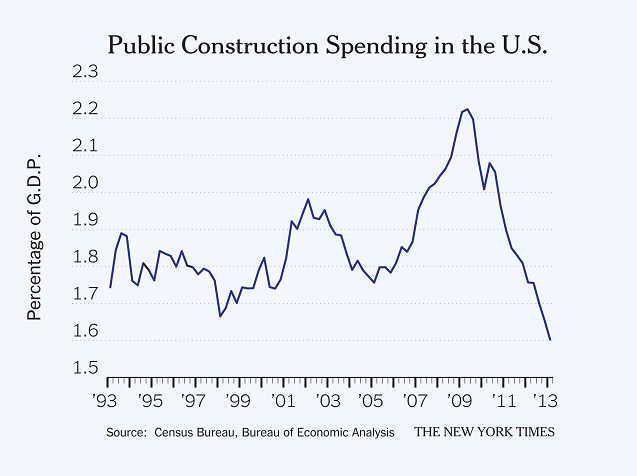Henry Petroski, an engineer who’s also a fine writer, lamented the decline of good construction in the United States in a recent New York Times op-ed. It’s a great read; I’m trying to figure out whether I believe his premise.
One thing is clear: there has been a shocking and inexcusable decline in public investment at a time when we should be doing far more.
Construction workers are suffering high unemployment; public borrowing costs are at record lows; the economy is essentially awash with excess labor and capital, begging to be used. And see what’s happening to public construction on the chart here.

But Mr. Petroski argues that private construction is also in a bad way, with cheap materials and poor workmanship.
It’s easy to collect anecdotes to that effect, and almost everyone has the sense that we used to build things better. A few years ago there was a condo building under construction at 86th Street and West End Avenue in New York; it bore a huge banner promising “Twenty-First Century Pre-War Living.” If you know New York, that meant high ceilings and thick walls.
And when I first moved to Princeton, N.J., for a while my wife and I lived in a brand-new McMansion in West Windsor, N.J., which was huge, with gigantic rooms, and was falling apart from day one.
But I worry about biased samples. Yes, the old buildings we know seem to be better built than the new ones. But isn’t there an issue of survivorship bias? Cheaply constructed buildings of the past were much more likely to have collapsed or for that matter have been torn down than the quality structures, so what we see now is the best of the bunch. The years after the Civil War were described at the time as the Age of Shoddy (originally a word for cheap fabric produced by war profiteers), and surely there were a lot of badly built tenements going up.
And when I was young – both as a graduate student and as an assistant professor – my friends and I lived in Boston-area “triple-deckers”; let me tell you, they were not well built. Some of my friends had a rope tied around their refrigerator door, because otherwise it would swing open thanks to the slanting floor.
Oh, and not everything worth doing is doing well. Cheap construction makes sense if you suspect that changing land use will make an expensively built structure obsolete fairly soon.
That said, I don’t know that Mr. Petroski is wrong; maybe Americans really are building badly. But I’d need better evidence.
We have 10 days to raise $50,000 — we’re counting on your support!
For those who care about justice, liberation and even the very survival of our species, we must remember our power to take action.
We won’t pretend it’s the only thing you can or should do, but one small step is to pitch in to support Truthout — as one of the last remaining truly independent, nonprofit, reader-funded news platforms, your gift will help keep the facts flowing freely.